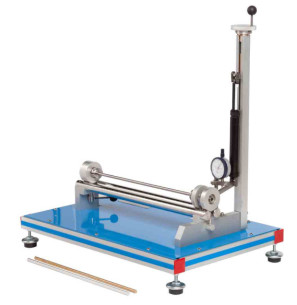EEFCR Gerät für Kriechprüfungen ("Creep")
INNOVATIVE SYSTEME
The Creep Testing Unit, "EEFCR", allows the student to determine experimentally the yield strength of plastic materials and the relation of deformation due to yield with time and temperature.
Erweiterungen
Laboratorien
ÄHNLICHE NEUIGKEITEN
ALLGEMEINE BESCHREIBUNG
The Creep Testing Unit, "EEFCR", for the creep testing is mounted on a structure of aluminum profiles which a painted steel panel is supported on.
The "EEFCR" unit is designed to carry out experiments on specimens of plastic materials. Due to the dependence on the temperature in this type of tests, there is a temperature conditioning box where the experiments are carried out. It is made of acrylic, which allows to observe the experiment´s development. The conditioning box is divided in two sections: the first has the placement for an isotherm bag that allows heat or cold the inside of the box, and the second one is for the placement of the specimens. Inside it, there is also an alcohol thermometer to measure the working temperature.
To carry out a creep experiment a constant load of tension must be applied to the specimen. The "EEFCR" unit has a load arm over which a hook for weights is hung on an end. This load arm multiplies the load applied to the specimen. The student will be able to apply loads by adding the weights supplied. The reaction will be the force applied to the specimen.
The unit has a dial indicator to measure the specimen elongation in a continuous way. The dial indicator measures the arm fall relevant to the horizontal and the specimen elongation is obtained by a simple trigonometric relation.
ÜBUNGEN UND GEFÜHRTE PRAKTIKEN
GEFÜHRTE PRAKTISCHE ÜBUNGEN IM HANDBUCH ENTHALTEN
- Experimental analyze the behaviour of different plastic materials.
- Experimental determination of the creep limit of different plastic materials.
- Determination of the temperature effect in the creep behaviour of a plastic material.
- Relation of the deformation caused by the creep in function of the time. Phases of the creep.
ERGÄNZENDE AUSRÜSTUNG
Gerät für Härteprüfungen "Brinell"
Gerät für Härteprüfungen "Brinell", "Vickers" und "Rockwell"
Gerät für Ermüdungsprüfungen, computergesteuert (PC)
Gerät für Ermüdungsprüfungen
Gerät für Charpy- und Izod-Schlagprüfungen
Universelles Gerät für Knickversuche
Gerät zur Untersuchung des Knickens von Stäben
Gerät für die Untersuchung der Euler'schen Knickmodi
Gerät für Torsion und Biegung
Gerät für Torsion
QUALITÄT

KUNDENDIENST

 Cookie-Präferenzen
Cookie-Präferenzen

















